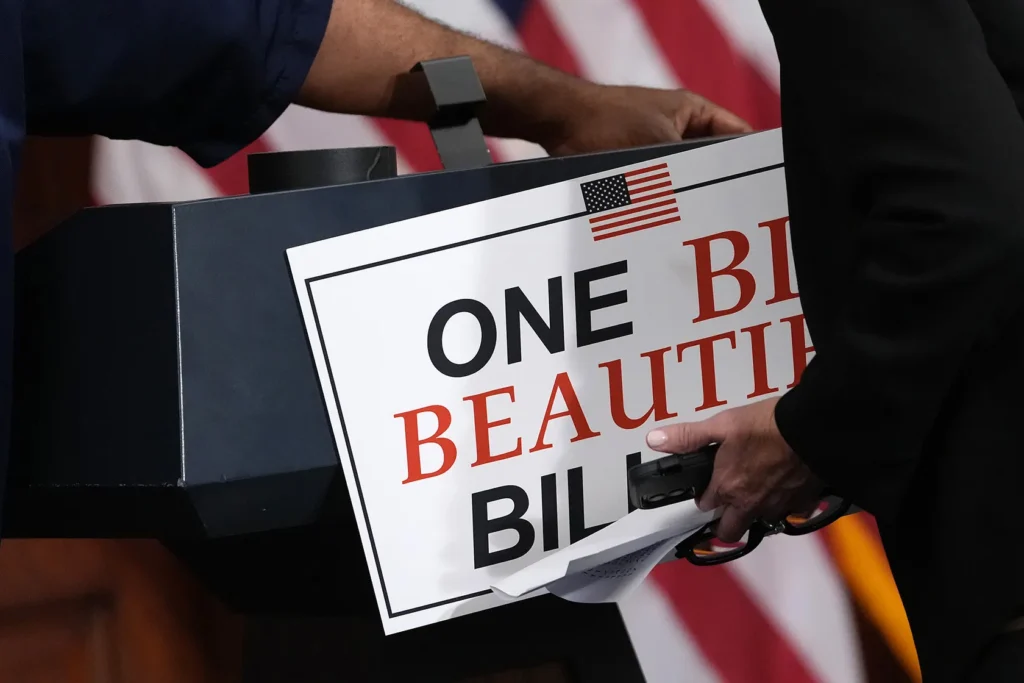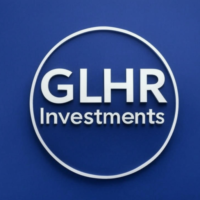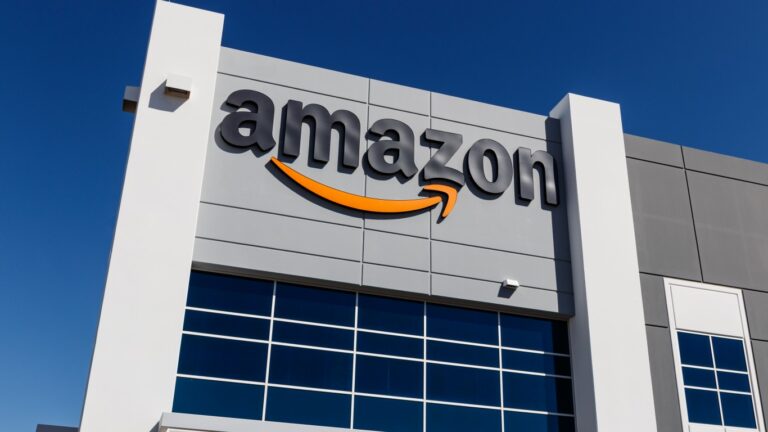
Trump’s 2025 tax bill reshapes consumer and investor landscapes.
At GLHR Investing, we’re unpacking “The One, Big, Beautiful Bill” (OBBBA), President Donald Trump’s sweeping tax and spending legislation passed by the House on May 22, 2025, and now under Senate scrutiny. Hailed as a “once-in-a-generation” economic overhaul, this 1,116-page bill extends Trump’s 2017 tax cuts, introduces new tax breaks, and reshapes social programs, all while raising the debt ceiling. With the U.S. economy facing 3% inflation, a 60% recession risk, and a volatile S&P 500 (SPY at $513.88, down 4.8% YTD), what does this mean for consumers and investors? Here’s a comprehensive breakdown of the bill’s provisions, its impact on wallets and portfolios, and how to navigate the fallout in 2025’s turbulent market.
- Overview of “The One, Big, Beautiful Bill”:
- Legislative Context: Introduced by the House Ways and Means Committee on May 11, 2025, and passed by a 215-214 House vote, the OBBBA is Trump’s flagship economic agenda, titled to reflect his campaign rhetoric. It combines tax cuts, spending reductions, border security, and energy policies, per web data. The Senate, with a Republican majority, is now deliberating, with potential changes expected before reaching Trump’s desk.
- Key Provisions:
- Tax Cuts and Extensions: Permanently extends the 2017 Tax Cuts and Jobs Act (TCJA) rates (10–37%), preventing a 22% tax hike for average taxpayers. Adds new breaks: no tax on tips, no tax on overtime, and deductions for U.S.-made car loan interest, per web data.
- Child Tax Credit: Increases from $2,000 to $2,500 through 2028, then reverts to $2,000 (inflation-adjusted), excluding low-income families without tax liability, per web data.
- SALT Deduction: Raises the state and local tax (SALT) deduction cap from $10,000 to $40,000 for households earning up to $500,000, benefiting high-tax state residents, per web data.
- Seniors’ Relief: Adds a $4,000 standard deduction for those 65+ (income limits: $75,000 single, $150,000 married), instead of eliminating Social Security benefit taxes, per web data.
- Trump Accounts: Creates $1,000 government-funded savings accounts for children born 2024–2028, with parental contributions up to $5,000/year, taxable at capital gains rates for education, home purchases, or business starts, per web data.
- Business Incentives: Extends 100% immediate expensing for equipment, R&D, and factories, increases the Section 199A small business deduction to 23%, and lowers domestic manufacturing taxes, per web data.
- Social Program Cuts: Imposes $880 billion in Medicaid and SNAP cuts, adding work requirements and tighter eligibility (e.g., excluding 1.4 million undocumented immigrants), per web data.
- Border Security: Allocates $45 billion for ICE detention, $14 billion for deportations, $50 billion for border wall construction, and funds 10,000 new ICE agents, per web data.
- Energy and Environment: Repeals Biden-era methane tax, cuts EV and clean energy incentives, and boosts oil/gas development, per web data.
- Other: Expands health savings accounts (HSAs), modernizes air traffic control, funds the Coast Guard, and prohibits court enforcement of contempt orders, per web data.
- Economic Claims: Trump and House Speaker Mike Johnson assert the bill will add $13,300 to family take-home pay, $11,600 to wages, and create 6.6–7.4 million jobs, with 5.2% GDP growth over four years, per web data. Critics dispute this, citing $3.2–$4.1 trillion in added deficits, per web data.
- Impact on Consumers:
- Positive Effects:
- Tax Savings: The TCJA extension saves the average family $1,700 annually (9 weeks of groceries), with no tax on tips/overtime saving workers $1,675–$1,750/year, per web data. Gig workers (e.g., Uber drivers) benefit from tip exemptions, per X post.
- SALT Relief: High-tax state residents (e.g., NY, CA) gain from the $40,000 SALT cap, saving ~$2,000–$5,000 for middle-class households, per web data.
- Child Tax Credit: Families with taxable income see up to $500 more per child through 2028, boosting disposable income, per web data.
- Seniors’ Deduction: The $4,000 deduction saves seniors ~$480/year (12% tax rate), though less than the $1,440 from untaxed Social Security benefits, per web data.
- Car Loan Deductions: Interest deductions for U.S.-made car loans reduce financing costs, potentially saving $500–$1,000/year, per web data.
- Trump Accounts: $1,000 accounts for newborns offer long-term savings (e.g., $5,000 by age 18 at 5% growth), but limited tax benefits vs. 529 plans, per web data.
- Negative Effects:
- Social Program Cuts: Medicaid and SNAP cuts could strip 10 million from healthcare and 7.6 million from food assistance by 2034, hitting low-income households hardest (2–4% income loss for the poorest 10%), per web data.
- Uneven Benefits: High earners gain 4% more resources by 2027, while low-income families lose 4% by 2033 due to reduced benefits, per the Congressional Budget Office (CBO), per web data.
- Tariff-Driven Costs: Tariffs add $1,200/household in 2025, with potential 9.1% goods price hikes by 2028, offsetting tax savings, per web data.
- Inflation Pressure: Tax cuts and tariffs could push inflation to 4% by 2026, raising living costs (e.g., 2.3% price increase), per web data.
- ACA Enrollment: A shortened Affordable Care Act enrollment period risks coverage gaps for the unemployed, per web data.
- Consumer Sentiment: Polls show 63% disapprove of Trump’s economic handling, with low confidence (50.8, a 12-year low) reflecting tariff and deficit fears, per web data and prior analyses.
- Positive Effects:
- Impact on Investors:
- Positive Effects:
- Corporate Tax Relief: Permanent TCJA cuts and 23% small business deductions boost earnings 5–10% by 2027, benefiting firms like Walmart (WMT) and small-cap ETFs (IWM), per web data.
- Manufacturing Boost: 100% expensing for factories and R&D could add 1 million jobs and $750 billion in small business growth, lifting industrial stocks (e.g., Nucor, NUE, +10% YTD), per web data.
- Energy Sector Gains: Repealing methane taxes and boosting oil/gas exploration support energy firms (e.g., Chevron, CVX), per web data.
- Border Security Spending: $109 billion for ICE and border walls could benefit defense contractors (e.g., Lockheed Martin, LMT), per web data.
- Market Sentiment: Trade deals (May 8, 12) and tax cuts spurred a ~1% SPY gain by May 9, with defensive sectors (utilities, staples) up 1–2%, per prior analyses.
- Negative Effects:
- Deficit and Debt Concerns: The bill adds $3.2–$4.1 trillion to deficits by 2034, per CBO and Tax Foundation, raising yields (10-year at 4.28%, 30-year at 5.09%) and borrowing costs, per web data. Moody’s Aa1 downgrade (May 19) fueled a 1% SPY drop, per web data.
- Bond Market Pressure: Rising yields and weak bond auctions (May 22) signal investor unease, potentially depressing equity valuations (e.g., tech, XLY down 1.5%), per web data.
- Tariff Volatility: The May 6 tariff threat and May 23 Apple tariff threat triggered 2.4% and 1.6% SPY drops, hitting tech (Nasdaq -1.8%) and retail (e.g., Nike, NKE), per web data and prior analyses.
- Social Program Cuts: Medicaid/SNAP reductions could curb consumer spending (1.8% growth), impacting retail and healthcare stocks (e.g., Pfizer, PFE, -1%), per web data.
- EV Sector Hit: Ending EV tax credits (e.g., $7,500 for new EVs) pressures EV stocks (e.g., Tesla, TSLA, -44% YTD), per web data and prior automotive analysis.
- Market Outlook: SPY’s May drop (-0.87%) reflects volatility, with June projected at $500–$530, per prior analyses. Domestic and defensive sectors outperform, while tech and cyclicals lag, per web data and X posts (@grok).
- Positive Effects:
- Investor Strategy:
- Opportunities:
- Domestic Manufacturing: Steel tariffs and expensing boost firms like Nucor (NUE, ~$160, 1.3% yield), per prior analyses. Buy on dips near $150 for 20–30% upside by 2027, per Goldman Sachs.
- Defensive Stocks: High-yield, tariff-resistant stocks like Verizon (VZ, ~$43, 6.2% yield) and TJX (TJX, ~$110, 1.4% yield) offer stability, per prior analyses. Buy VZ near $40, TJX near $105.
- Energy Sector: Oil/gas firms (e.g., Chevron, CVX, ~$150, 4.2% yield) benefit from deregulation, per web data. Buy on dips near $140.
- Holds:
- Tech Stocks: Apple (AAPL, ~$202, 0.5% yield) faces tariff risks but has long-term strength, per web data. Hold and monitor trade talks, per prior analyses.
- Retail Stocks: Nike (NKE, ~$70, 2.1% yield) struggles with tariff costs but retains brand loyalty, per prior analyses. Hold for H2 2025 recovery.
- ETFs: iShares U.S. Consumer Staples ETF (IYK, 2% yield) for defensive exposure, or SPDR S&P Metals & Mining ETF (XME) for manufacturing, per Seeking Alpha.
- Allocation: Allocate 5–10% to defensive and domestic stocks, with 3–5% in gold (GLD, +3%) or utilities (XLU, +1%) to hedge volatility, per prior analyses.
- Timing: Buy on SPY dips near $500, per Trade That Swing. Dollar-cost average to manage VIX (~35), per Schwab.
- Monitor: June 17–18 FOMC meeting, May 30 PCE inflation, U.S.-China trade talks, and Q2 earnings (July 2025) for market signals, per NerdWallet. Track steel tariff and drug price outcomes, per X posts (@WhiteHouse).
- Opportunities:
- Consumer Implications:
- Winners: Middle and high-income families gain from tax cuts ($1,700–$5,000/year), SALT relief ($2,000–$5,000), and car loan deductions ($500–$1,000), per web data. Tipped workers (e.g., servers, Uber drivers) and seniors see modest relief, per web data and X post (@WhiteHouse).
- Losers: Low-income households lose 2–4% income from Medicaid/SNAP cuts, facing higher costs ($1,200/year from tariffs), per web data. Unemployed individuals risk ACA coverage gaps, per web data.
- Long-Term Risks: Deficit-driven yield spikes (4.5–5%) could raise loan rates (e.g., mortgages, credit cards), offsetting tax savings, per web data. Inflation (4% by 2026) may erode purchasing power, per web data.
- Investor Implications:
- Winners: Domestic manufacturers (NUE), energy firms (CVX), and defensive stocks (VZ, TJX) gain from tariffs, tax cuts, and recession fears, per web data and prior analyses.
- Losers: Tech (AAPL, NVDA), retail (NKE), and EV stocks (TSLA) face tariff costs and spending cuts, per web data. High P/E firms risk valuation pressure from rising yields, per web data.
- Long-Term Outlook: The bill’s 0.8% GDP boost by 2034 is offset by tariffs and deficits, per Penn Wharton. Investors should prioritize tariff-resistant, high-yield stocks, per web data.
- Why It Matters: Trump’s “One, Big, Beautiful Bill” reshapes the U.S. economy, delivering tax cuts ($1,700/family) and new breaks (no tax on tips) for consumers, but slashing Medicaid/SNAP and adding $3.2–$4.1 trillion in deficits. Investors face a volatile SPY (-15.6% YTD), with domestic manufacturing and defensives outperforming amid tariff and recession risks. With June’s steel tariffs and trade talks looming, strategic buys (NUE, VZ) and holds (AAPL, NKE) are key. At GLHR Investing, we’re here to help you navigate this economic transformation, styling your portfolio for 2025’s challenges.
Invest smart with GLHR Investing—turn Trump’s bill into your win!
Disclaimer: GLHR Investing is not a financial adviser; please consult one.








